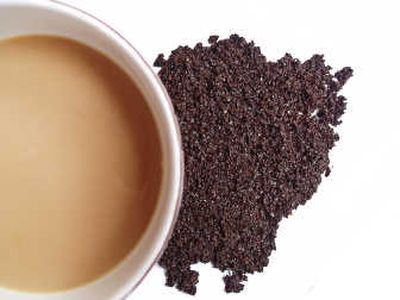Grounds help your garden grow

Almost weekly I get two or three packages of Starbucks coffee grounds. I spread the grounds on my lawn and garden. What value are the grounds on my plants?
Ray
Coffee grounds are great to add to the garden. Because they have been processed when the coffee was made, they are already partially broken down and will quickly complete the process in the compost pile. Don’t forget to throw in the paper filters too. In the garden they can be spread around plants and worked into the soil where they add nitrogen. They do acidify the soil a bit so try them around rhododendrons, azaleas and blueberries. Some people have had good luck using them around plants that slugs like. Evidently the residual caffeine in the grounds wires the slug with a deadly effect. House plants can benefit from a top dressing once in a while. If you are keeping a worm bin, feed a small amount to the worms.
Thinking ahead
How do you eliminate weeds in the garden to prepare for planting?
Pam Hansen, Spokane
If we have mild spells during the winter, it is a great time to get a jump on the weeds. Shred up all the garden leavings with a shredder or mower now and stack them up. Till the garden and then spread out all the shredded trimmings over the garden two to four inches deep. If you don’t have enough trimmings, shred or mow up some pine needles and leaves and add them. Make sure you cover areas that are particularly weedy. Grain straw can also be used. Don’t use hay as it still has a lot of seed in it. Check through the winter for those cold tolerant weeds that pop up. Leave the mulch in place in the spring and just clear enough space for your rows. It will take a little longer for the soil to warm up but it will cut your work down considerably.
Bitter apples
My apples have developed brown, pithy spots. They are also bitter. The tree is growing in our lawn. What causes this and how do I treat this
Barbara Swanson, Spokane
It’s a condition called bitter pit which is caused by a calcium deficiency in the fruit. It is often brought on by hot, dry weather in July and August – just like we had last summer. One of the most common causes for the home fruit grower is the application of high nitrogen fertilizer around the tree which disrupts the calcium balance. I had a Gravenstein in a lawn area and after I stopped applying lawn fertilizer under it, the condition disappeared. It also helps to make sure the tree is getting enough water deep down where its roots are. Lawn sprinklers usually don’t get water deep enough. If the condition persists, sprays of calcium chloride or calcium nitrate can be applied by a professional.